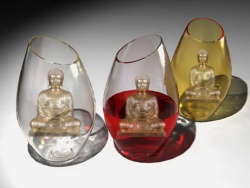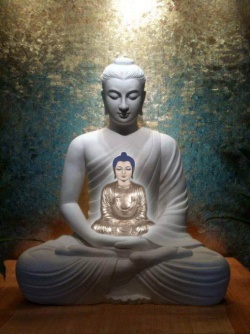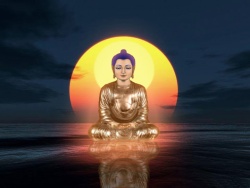Difference between revisions of "Sagaramegha"
m (Text replacement - "[[[" to "([[") |
|||
| Line 6: | Line 6: | ||
[[Haiyun]], the [[Bhikkhu]] who [[initiated]] me into the [[Huayen]] [[Buddhist]] [[Sangha]], in [[Wikipedia:Mandarin Chinese|Mandarin]] is [[海雲]] [[hǎi yún]]. He chooses his [[Dharma name]] from the 40-Fascicles [[Avatamsaka Sutra]] ([[四十卷華嚴經]]) Ch. 5, “On Entering Into The [[Inconceivable]] [[State]] Of {{Wiki|Emancipation}} By The Practice And [[Vows Of The Bodhisattva]] [[Samantabhadra]] Of The [[Mahavaipulya]] [[Buddha]] [[Avatamsaka Sutra]],” opening paragraph, which [[Sakyamuni Buddha]] described the story of [[Kumara]] [[Sudhana’s]] ([[善財童子]]) long [[spiritual path]] toward [[attainment]] [[Absolute Truth]] and [[liberation]] to become a [[Buddha]]. | [[Haiyun]], the [[Bhikkhu]] who [[initiated]] me into the [[Huayen]] [[Buddhist]] [[Sangha]], in [[Wikipedia:Mandarin Chinese|Mandarin]] is [[海雲]] [[hǎi yún]]. He chooses his [[Dharma name]] from the 40-Fascicles [[Avatamsaka Sutra]] ([[四十卷華嚴經]]) Ch. 5, “On Entering Into The [[Inconceivable]] [[State]] Of {{Wiki|Emancipation}} By The Practice And [[Vows Of The Bodhisattva]] [[Samantabhadra]] Of The [[Mahavaipulya]] [[Buddha]] [[Avatamsaka Sutra]],” opening paragraph, which [[Sakyamuni Buddha]] described the story of [[Kumara]] [[Sudhana’s]] ([[善財童子]]) long [[spiritual path]] toward [[attainment]] [[Absolute Truth]] and [[liberation]] to become a [[Buddha]]. | ||
| − | In this story, [[Kumara Sudhana]], already a [[Bodhisattva]] ([[菩薩]]) learned from 53 different {{Wiki|benevolent}} [[spiritual]] advisors before he finally [[attained]] [[Ultimate Enlightenment]] ([[阿耨多羅三藐三菩提]] [[ANUTTARA SAMYAK SAMBODHI]]) and became a [[Buddha]]. First, he sought the [[spiritual]] guidance of [[Manjusri Bodhisattva]] ([[文殊師利菩薩]], who was Himself a [[Buddha]], but He [[manifests]] Himself as a [[Bodhisattva]] to be the [[teacher]] of seven subsequent [[Buddhas]]). [[Manjusri Bodhisattva]], having answered all of [[Kumara Sudhana’s]] questions, instructed [[Kumara Sudhana]] to go [[south]] to the [[Kingdom of Sea Door]] ([[海門國]]) to seek the advice of [[海雲比丘]] [[Sagaramegha]], where [[Kumara]] [[Sudhana]] asked [[海雲比丘]] [[Sagaramegha]] how to {{Wiki|renounce}} his [[worldly life]] ([[捨凡夫家]]) to be born in the [[Family of Tathagata]] ([[生於如來家]]), how to cross the [[river of births and deaths]] ([[斷生死流]]) over to the [[river]] of [[Buddha’s]] [[purified]] acts ([[入佛淨行流]]), how to destroy the [[Sansara wheel]] ([[壞生死輪]]) to achieve the [[Wheel of Great Vows]] ([[成就大願輪]]), how to control his [[sea of passions and desires]] ([[竭愛欲海]]) to add to the Sea of [[Great Compassion]] ([[增長大悲海]]), how to shut the doors of the [[three forms of existence]] ([[kama-loka]], [[rupa-loka]], and [[arupa-loka]]) and of the [[eight forms of suffering]] ([[閉三塗八難門]] ) to open the doors to [[Nirvana for man and gods]] ([[開人天涅槃門]]), how to exit the city in which all [[beings]] are [[bound]] in the [[three realms of existence]] ([[出三有]] | + | In this story, [[Kumara Sudhana]], already a [[Bodhisattva]] ([[菩薩]]) learned from 53 different {{Wiki|benevolent}} [[spiritual]] advisors before he finally [[attained]] [[Ultimate Enlightenment]] ([[阿耨多羅三藐三菩提]] [[ANUTTARA SAMYAK SAMBODHI]]) and became a [[Buddha]]. First, he sought the [[spiritual]] guidance of [[Manjusri Bodhisattva]] ([[文殊師利菩薩]], who was Himself a [[Buddha]], but He [[manifests]] Himself as a [[Bodhisattva]] to be the [[teacher]] of seven subsequent [[Buddhas]]). [[Manjusri Bodhisattva]], having answered all of [[Kumara Sudhana’s]] questions, instructed [[Kumara Sudhana]] to go [[south]] to the [[Kingdom of Sea Door]] ([[海門國]]) to seek the advice of [[海雲比丘]] [[Sagaramegha]], where [[Kumara]] [[Sudhana]] asked [[海雲比丘]] [[Sagaramegha]] how to {{Wiki|renounce}} his [[worldly life]] ([[捨凡夫家]]) to be born in the [[Family of Tathagata]] ([[生於如來家]]), how to cross the [[river of births and deaths]] ([[斷生死流]]) over to the [[river]] of [[Buddha’s]] [[purified]] acts ([[入佛淨行流]]), how to destroy the [[Sansara wheel]] ([[壞生死輪]]) to achieve the [[Wheel of Great Vows]] ([[成就大願輪]]), how to control his [[sea of passions and desires]] ([[竭愛欲海]]) to add to the Sea of [[Great Compassion]] ([[增長大悲海]]), how to shut the doors of the [[three forms of existence]] ([[kama-loka]], [[rupa-loka]], and [[arupa-loka]]) and of the [[eight forms of suffering]] ([[閉三塗八難門]] ) to open the doors to [[Nirvana for man and gods]] ([[開人天涅槃門]]), how to exit the city in which all [[beings]] are [[bound]] in the [[three realms of existence]] ([[出三有]] ([[kama-loka]], [[rupa-loka]], and [[arupa-loka]]] [[繫縛城]]), to enter the city of [[liberation]] by acquiring [[Buddha’s wisdom]] ([[入種智解脫城]]), and finally how to relinquish [[all worldly gems, toys, possessions, and means]] ([[棄捨一切珍玩資具]]) to do good for the [[benefit of all beings]] ([[饒益攝受一切眾生]]). |
Excerpt from 40-Fascicles [[Avatamsaka Sutra]] ([[四十卷華嚴經]]) Ch. 5 “On Entering Into The [[Inconceivable]] [[State]] Of {{Wiki|Emancipation}} By The Practice And [[Vows Of The Bodhisattva]] [[Samantabhadra]] Of The [[Mahavaipulya Buddha]] [[Avatamsaka Sutra]]]],” opening paragraph – English translation by [[Master]] [[Longyen]] ([[釋隆嚴]]). | Excerpt from 40-Fascicles [[Avatamsaka Sutra]] ([[四十卷華嚴經]]) Ch. 5 “On Entering Into The [[Inconceivable]] [[State]] Of {{Wiki|Emancipation}} By The Practice And [[Vows Of The Bodhisattva]] [[Samantabhadra]] Of The [[Mahavaipulya Buddha]] [[Avatamsaka Sutra]]]],” opening paragraph – English translation by [[Master]] [[Longyen]] ([[釋隆嚴]]). | ||
Revision as of 02:15, 4 April 2016
Sagaramegha (Skt. Sāgaramegha; Tib. རྒྱ་མཚོ་སྤྲིན་, Wyl. rgya mtsho sprin) was a master of the Svatantrika Madhyamika school. He wrote a commentary on Asanga's Bodhisattva Bhumis.
Sagaramegha; 海雲比丘; Sagaramegha;
Haiyun, the Bhikkhu who initiated me into the Huayen Buddhist Sangha, in Mandarin is 海雲 hǎi yún. He chooses his Dharma name from the 40-Fascicles Avatamsaka Sutra (四十卷華嚴經) Ch. 5, “On Entering Into The Inconceivable State Of Emancipation By The Practice And Vows Of The Bodhisattva Samantabhadra Of The Mahavaipulya Buddha Avatamsaka Sutra,” opening paragraph, which Sakyamuni Buddha described the story of Kumara Sudhana’s (善財童子) long spiritual path toward attainment Absolute Truth and liberation to become a Buddha.
In this story, Kumara Sudhana, already a Bodhisattva (菩薩) learned from 53 different benevolent spiritual advisors before he finally attained Ultimate Enlightenment (阿耨多羅三藐三菩提 ANUTTARA SAMYAK SAMBODHI) and became a Buddha. First, he sought the spiritual guidance of Manjusri Bodhisattva (文殊師利菩薩, who was Himself a Buddha, but He manifests Himself as a Bodhisattva to be the teacher of seven subsequent Buddhas). Manjusri Bodhisattva, having answered all of Kumara Sudhana’s questions, instructed Kumara Sudhana to go south to the Kingdom of Sea Door (海門國) to seek the advice of 海雲比丘 Sagaramegha, where Kumara Sudhana asked 海雲比丘 Sagaramegha how to renounce his worldly life (捨凡夫家) to be born in the Family of Tathagata (生於如來家), how to cross the river of births and deaths (斷生死流) over to the river of Buddha’s purified acts (入佛淨行流), how to destroy the Sansara wheel (壞生死輪) to achieve the Wheel of Great Vows (成就大願輪), how to control his sea of passions and desires (竭愛欲海) to add to the Sea of Great Compassion (增長大悲海), how to shut the doors of the three forms of existence (kama-loka, rupa-loka, and arupa-loka) and of the eight forms of suffering (閉三塗八難門 ) to open the doors to Nirvana for man and gods (開人天涅槃門), how to exit the city in which all beings are bound in the three realms of existence (出三有 (kama-loka, rupa-loka, and arupa-loka] 繫縛城), to enter the city of liberation by acquiring Buddha’s wisdom (入種智解脫城), and finally how to relinquish all worldly gems, toys, possessions, and means (棄捨一切珍玩資具) to do good for the benefit of all beings (饒益攝受一切眾生).
Excerpt from 40-Fascicles Avatamsaka Sutra (四十卷華嚴經) Ch. 5 “On Entering Into The Inconceivable State Of Emancipation By The Practice And Vows Of The Bodhisattva Samantabhadra Of The Mahavaipulya Buddha Avatamsaka Sutra]],” opening paragraph – English translation by Master Longyen (釋隆嚴).
Haiyun was inspired by Kumara Sudhana’s great vows and by the spiritual advice 海雲比丘 Sagaramegha gave Kumara Sudhana when he read the Avatamsaka Sutra. Therefore he chose to name himself Haiyun meaning Sea Cloud in English. I have included below the original Chinese scriptural text of the 40-Fascicles Avatamsaka Sutra (四十卷華嚴經) Ch. 5, “On Entering Into The Inconceivable State Of Emancipation By The Practice And Vows Of The Bodhisattva Samantabhadra Of The Mahavaipulya Buddha Avatamsaka Sutra,” for anyone interested in further study.
The Mahavaipulya-buddhāvataṃsaka-sūtra (Sanskrit: “The Great and Vast Buddha Garland Sutra”), also called Garland Sūtra, or Avatamsaka Sutra (preserved in both Tibetan and Chinese versions was the sublime revelation by Sakyamuni Muni Buddha upon his Enlightenment. He assumed the dharma body of the Great Deity Maha Vairocana, (also in Tibetan Buddhism, and as Dainichi Nyorai 大日如來, of Shingon Buddhism of Japan,) and spoke the Dharm simultaneously in nine assemblies of man, devatas, Bodhisattvas, and Buddhas in seven locations. Only the shortest version of the Sutra is comprehensible to man and therefore still remains on earth. It contains 10, 000, 000, 095, 048 words and is the basic Sutra practice cultivated by the Avatamsaka School of Buddhism. This Sutra is most read in the Da Huayen Monastery, founded by Ven. Haiyun.
To put you in the present context from the historical perspective of this Sutra, in a recent conversation between Sri Swami Rajarshi Muni, Founder of the Lakulish International Fellowship’s Enlightenment Mission (LIFE Mission) and Haiyun, Muniji explained that Samantabhadra is Lord Shiva the King of the Universe while Haiyun said that Samantabhadra is the Primeval Buddha. When we are liberated, we become one with Barhma, Lord Shiva, or Samantabhadra the Primeval Buddha in whose body all Buddhas of the past, present and future dwell.
大方廣佛華嚴經卷第五 罽賓國三藏般若奉 詔譯 入不思議解脫境界普賢行願品 爾時善財童子。聞善知識教。一心正念。隨順思惟所有 智慧光明門。隨順通達所有甚深解脫門。隨順憶持所有自在三昧門。隨順敬奉所有清淨教誨門。隨順觀察所見諸佛威德門。隨順欣樂所見諸佛住處門。隨順解了所見諸佛軌則門。隨順思念所見諸佛出現門。隨順趣入所見諸佛法界門。隨順安住所見諸佛境界門。漸次南行。向海門國。詣海雲比丘所。頂禮雙足。遶無數匝。於前合掌。白言聖者。我已先發阿耨多羅三藐三菩提心。欲入甚深最上智海。而未知菩薩云何能具菩薩行。長養菩提種。云何能捨凡夫家。生於如來家。云何能度生死海。入佛智慧海。云何能離凡愚地。入佛最勝地。云何能斷生死流。入佛淨行流。云何能壞生死輪。成就大願輪。云何能滅魔境界。顯示佛境界。云何能竭愛欲海。增長大悲海。云何能閉三塗八難門。開人天涅槃門。云何能出三有繫縛城。入種智解脫城。云何能棄捨一切珍玩資具。饒益攝受一切眾生。唯願慈哀。為我宣說。時海雲比丘。告善財言。善男子。汝已發阿耨多羅三藐三菩提心耶。善財言唯。我已先發阿耨多羅三藐三菩提心。海雲告言。善哉善哉。善男子。發菩提心者。不可得聞。何況自能深心發趣。善男子。若諸眾生。未曾修種深固善根。則不能發阿耨多羅三藐三菩提心。是故菩薩。要得平等無礙境界普門善根光明照故。要得真實巧方便藏正道三昧光明照故。要得積集功德海藏廣大福聚莊嚴身故。要得增長種種白法。念念出生無休息故。要能供事真善知識。諮問法要。無疲厭故。要捨慳吝。無所藏積。於身命財。無愛著故。要離憍慢。心無高下。安住不動。如大地故。要恒慈愍。隨順眾生。平等饒益。無違逆故。要處生死。於惡趣中。度苦眾生。心不捨故。要恒觀察如來境界。欣求修習。至究竟故。要恒利益安樂一切諸眾生故。如是乃能發菩提心。發菩提心者。所謂拔濟苦惱諸眾生故。發大悲心。平等福祐諸眾生故。發大慈心。除滅眾生諸苦蘊故。發安樂心。為息眾生不善心故。發饒益心。救護怖畏諸眾生故。發哀愍心。捨離執著障礙法故。發無著心。普遍法界諸佛剎故。發廣大心。等虛空界無不往故。發無邊心。見一切佛妙色身故。發無垢心。觀三世法智無盡故。發清淨心。為欲普入一切智智甚深海故。發大智心。發如是等種種心故。是名菩薩發菩提心。


